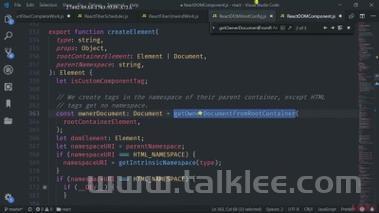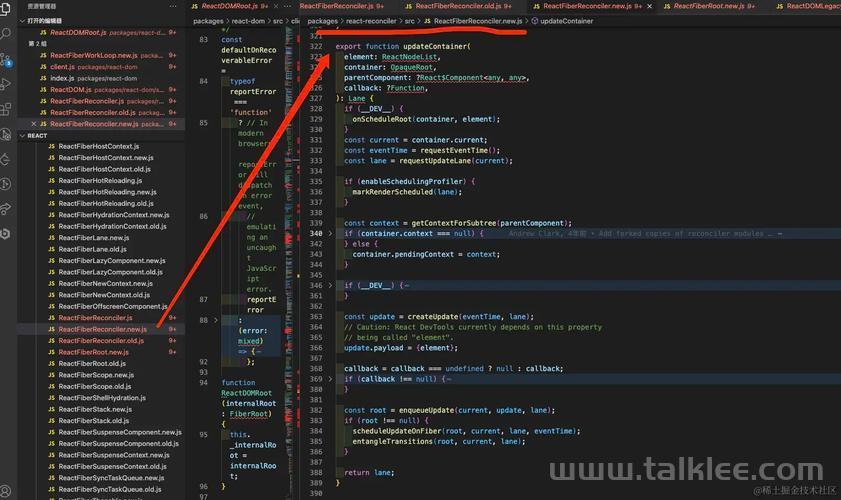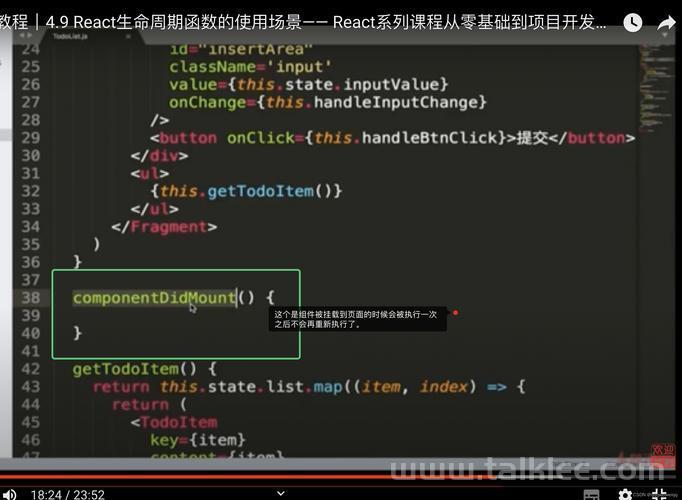前端 React 页面容器源码级深度剖析(三)
前端 React 页面容器源码级深度剖析
本人掘金号,欢迎点击关注:掘金号地址
本人公众号,欢迎点击关注:公众号地址
一、引言
在前端开发领域,React 凭借其高效、灵活的特性成为了构建用户界面的热门选择。页面容器作为 React 应用中不可或缺的一部分,承担着管理页面布局、组织子组件以及处理页面状态等重要职责。深入理解 React 页面容器的原理和源码,有助于开发者更高效地使用 React 进行开发,提升应用的性能和可维护性。本文将从源码级别对前端 React 的页面容器进行深入分析。
二、页面容器基础
2.1 页面容器的定义与作用
页面容器是一种特殊的 React 组件,它通常用于包裹其他子组件,为它们提供一个统一的布局和上下文环境。页面容器可以管理页面的整体状态,处理与页面相关的逻辑,如路由切换、数据加载等。
jsx
// 定义一个简单的页面容器组件
// 该组件接收子组件作为 props,并将它们渲染在一个 div 中
const PageContainer = (props) => {
// 从 props 中获取子组件
const { children } = props;
// 返回一个包含子组件的 div 元素
return {children};
};
// 使用页面容器组件
const App = () => {
return (
{/* 这里可以放置其他子组件 */}
Welcome to the page!
);
};
2.2 页面容器的分类
根据功能和用途的不同,页面容器可以分为多种类型,常见的有布局容器、状态容器和路由容器。
2.2.1 布局容器
布局容器主要负责页面的布局,它可以使用 CSS 布局技术(如 Flexbox、Grid 等)来排列子组件。
jsx
// 定义一个使用 Flexbox 布局的页面容器组件
// 该组件将子组件水平排列
const FlexPageContainer = (props) => {
const { children } = props;
return (
{ display: 'flex', justifyContent: 'space-around' }}
{children}
);
};
// 使用 FlexPageContainer 组件
const FlexApp = () => {
return (
Item 1
Item 2
Item 3
);
};
2.2.2 状态容器
状态容器用于管理页面的状态,它可以使用 React 的状态管理机制(如 useState、useReducer 或 Redux 等)来存储和更新页面状态。
jsx
import React, { useState } from'react';
// 定义一个状态容器组件
// 该组件管理一个计数器状态,并将计数器的值传递给子组件
const StatePageContainer = (props) => {
// 使用 useState 钩子初始化计数器状态为 0
const [count, setCount] = useState(0);
const { children } = props;
// 增加计数器的函数
const increment = () => {
setCount(count + 1);
};
return (
{/* 将计数器的值和增加函数传递给子组件 */}
{React.Children.map(children, child => React.cloneElement(child, { count, increment }))}
);
};
// 使用 StatePageContainer 组件
const StateApp = () => {
const CounterDisplay = (props) => {
const { count, increment } = props;
return (
Count: {count}
increment}Increment
);
};
return (
);
};
2.2.3 路由容器
路由容器用于处理页面的路由切换,它可以使用 React Router 等路由库来实现单页面应用(SPA)的路由功能。
jsx
import React from'react';
import { BrowserRouter as Router, Routes, Route } from'react-router-dom';
// 定义一个路由容器组件
// 该组件使用 React Router 来处理不同路径的页面切换
const RouterPageContainer = () => {
return (
{/* 定义不同路径对应的页面组件 */}
);
};
// 定义首页组件
const HomePage = () => {
return Home Page
;
};
// 定义关于页面组件
const AboutPage = () => {
return About Page
;
};
// 使用 RouterPageContainer 组件
const RouterApp = () => {
return ;
};
三、页面容器的状态管理
3.1 局部状态管理
页面容器可以使用 React 的 useState 或 useReducer 钩子来管理局部状态。
jsx
import React, { useState } from'react';
// 定义一个使用 useState 管理局部状态的页面容器组件
// 该组件管理一个输入框的值状态
const LocalStatePageContainer = (props) => {
// 使用 useState 钩子初始化输入框的值状态为空字符串
const [inputValue, setInputValue] = useState('');
const { children } = props;
// 处理输入框变化的函数
const handleInputChange = (e) => {
setInputValue(e.target.value);
};
return (
inputValue} onChange={handleInputChange} /
{/* 将输入框的值传递给子组件 */}
{React.Children.map(children, child => React.cloneElement(child, { inputValue }))}
);
};
// 使用 LocalStatePageContainer 组件
const LocalStateApp = () => {
const DisplayInput = (props) => {
const { inputValue } = props;
return You entered: {inputValue}
;
};
return (
);
};
3.2 全局状态管理
当多个页面容器需要共享状态时,可以使用全局状态管理库,如 Redux 或 MobX。下面以 Redux 为例进行分析。
jsx
// 安装 Redux 和 React-Redux
// npm install redux react-redux
// 定义 action types
// 定义一个常量,表示增加计数器的 action 类型
const INCREMENT = 'INCREMENT';
// 定义一个常量,表示减少计数器的 action 类型
const DECREMENT = 'DECREMENT';
// 定义 action creators
// 增加计数器的 action 创建函数
const increment = () => ({
type: INCREMENT
});
// 减少计数器的 action 创建函数
const decrement = () => ({
type: DECREMENT
});
// 定义 reducer
// 定义一个计数器的 reducer 函数,接收状态和 action 作为参数
const counterReducer = (state = { count: 0 }, action) => {
// 根据 action 的类型进行不同的处理
switch (action.type) {
case INCREMENT:
// 返回一个新的状态对象,计数器值加 1
return {
...state,
count: state.count + 1
};
case DECREMENT:
// 返回一个新的状态对象,计数器值减 1
return {
...state,
count: state.count - 1
};
default:
// 如果 action 类型不匹配,返回原始状态
return state;
}
};
// 创建 store
import { createStore } from'redux';
// 使用 createStore 函数创建一个 store,传入计数器的 reducer
const store = createStore(counterReducer);
// 使用 React-Redux 连接组件
import React from'react';
import { Provider, connect } from'react-redux';
// 定义一个展示组件,用于显示计数器的值
const CounterDisplay = (props) => {
// 从 props 中获取计数器的值
const { count, increment, decrement } = props;
// 返回一个包含计数器值和按钮的 div 元素
return (
);
};
// 定义 mapStateToProps 函数,将状态映射到组件的 props
const mapStateToProps = (state) => ({
count: state.count
});
// 定义 mapDispatchToProps 函数,将 action 创建函数映射到组件的 props
const mapDispatchToProps = (dispatch) => ({
increment: () => dispatch(increment()),
decrement: () => dispatch(decrement())
});
// 使用 connect 函数将展示组件与 Redux store 连接起来
const ConnectedCounterDisplay = connect(
mapStateToProps,
mapDispatchToProps
)(CounterDisplay);
// 定义一个使用 Redux 全局状态管理的页面容器组件
const ReduxPageContainer = () => {
return (
store}
);
};
四、页面容器的生命周期
4.1 类组件的生命周期
如果页面容器使用类组件实现,它会有自己的生命周期方法。
jsx
import React, { Component } from'react';
// 定义一个类组件的页面容器
// 该组件在生命周期方法中进行一些操作
class ClassPageContainer extends Component {
// 构造函数,初始化状态
constructor(props) {
super(props);
// 初始化计数器状态为 0
this.state = {
count: 0
};
console.log('Constructor called');
}
// 组件挂载前调用
componentWillMount() {
console.log('componentWillMount called');
}
// 组件挂载后调用
componentDidMount() {
console.log('componentDidMount called');
// 在组件挂载后启动一个定时器,每隔 1 秒增加计数器的值
this.timer = setInterval(() => {
this.setState((prevState) => ({
count: prevState.count + 1
}));
}, 1000);
}
// 组件接收新的 props 时调用
componentWillReceiveProps(nextProps) {
console.log('componentWillReceiveProps called');
}
// 判断组件是否应该更新
shouldComponentUpdate(nextProps, nextState) {
console.log('shouldComponentUpdate called');
// 比较当前状态和下一个状态的计数器值,如果相同则不更新组件
return this.state.count!== nextState.count;
}
// 组件更新前调用
componentWillUpdate(nextProps, nextState) {
console.log('componentWillUpdate called');
}
// 组件更新后调用
componentDidUpdate(prevProps, prevState) {
console.log('componentDidUpdate called');
}
// 组件即将卸载时调用
componentWillUnmount() {
console.log('componentWillUnmount called');
// 清除定时器,避免内存泄漏
clearInterval(this.timer);
}
// 渲染方法,返回组件的 UI
render() {
// 从状态中获取计数器的值
const { count } = this.state;
const { children } = this.props;
// 返回一个包含计数器值和子组件的 div 元素
return (
Count: {count}
{children}
);
}
}
// 使用 ClassPageContainer 组件
const ClassApp = () => {
return (
Some content inside the container
);
};
4.2 函数组件的生命周期钩子
函数组件没有传统的生命周期方法,但可以使用 useEffect 钩子来模拟生命周期行为。
jsx
import React, { useState, useEffect } from'react';
// 定义一个函数组件的页面容器
// 该组件使用 useEffect 钩子模拟生命周期方法
const FunctionPageContainer = (props) => {
// 使用 useState 钩子初始化计数器状态为 0
const [count, setCount] = useState(0);
const { children } = props;
// 模拟 componentDidMount 和 componentDidUpdate
useEffect(() => {
console.log('useEffect called');
// 在组件挂载和更新后执行的操作
document.title = `Count: ${count}`;
// 返回一个清理函数,模拟 componentWillUnmount
return () => {
console.log('Cleanup function called');
};
}, [count]); // 只有当 count 状态变化时才会重新执行 useEffect
// 增加计数器的函数
const increment = () => {
setCount(count + 1);
};
return (
Count: {count}
increment}Increment
{children}
);
};
// 使用 FunctionPageContainer 组件
const FunctionApp = () => {
return (
Some content inside the container
);
};
五、页面容器的事件处理
5.1 基本事件处理
页面容器可以处理各种事件,如点击事件、输入事件等。
jsx
import React from'react';
// 定义一个处理点击事件的页面容器组件
// 该组件在点击按钮时触发一个事件处理函数
const ClickEventPageContainer = (props) => {
const { children } = props;
// 点击按钮的事件处理函数
const handleClick = () => {
console.log('Button clicked!');
};
return (
handleClick}Click me
{children}
);
};
// 使用 ClickEventPageContainer 组件
const ClickEventApp = () => {
return (
Some content inside the container
);
};
5.2 事件委托
事件委托是一种将事件处理逻辑委托给父元素的技术,页面容器可以使用事件委托来处理子组件的事件。
jsx
import React from'react';
// 定义一个使用事件委托的页面容器组件
// 该组件将列表项的点击事件委托给父元素处理
const EventDelegationPageContainer = (props) => {
const { children } = props;
// 处理列表项点击的事件处理函数
const handleListItemClick = (e) => {
if (e.target.tagName === 'LI') {
console.log('List item clicked:', e.target.textContent);
}
};
return (
handleListItemClick}
- Item 1
- Item 2
- Item 3
Some content inside the container
); };六、页面容器的性能优化
6.1 避免不必要的渲染
可以使用 React.memo(函数组件)和 shouldComponentUpdate(类组件)来避免不必要的渲染。
jsx
// 函数组件使用 React.memo
import React from'react';
// 定义一个使用 React.memo 优化的页面容器组件
// 该组件只有在 props 发生变化时才会重新渲染
const MemoPageContainer = React.memo((props) => {
const { children } = props;
console.log('MemoPageContainer rendered');
return (
{children}
);
});
// 使用 MemoPageContainer 组件
const MemoApp = () => {
return (
Some content inside the container
);
};
// 类组件使用 shouldComponentUpdate
import React, { Component } from'react';
// 定义一个使用 shouldComponentUpdate 优化的页面容器组件
// 该组件只有在状态或 props 发生变化时才会重新渲染
class ShouldUpdatePageContainer extends Component {
// 判断组件是否应该更新
shouldComponentUpdate(nextProps, nextState) {
// 简单比较当前 props 和下一个 props 是否相等
return JSON.stringify(this.props)!== JSON.stringify(nextProps);
}
// 渲染方法,返回组件的 UI
render() {
const { children } = this.props;
console.log('ShouldUpdatePageContainer rendered');
return (
{children}
);
}
}
// 使用 ShouldUpdatePageContainer 组件
const ShouldUpdateApp = () => {
return (
Some content inside the container
);
};
6.2 代码分割与懒加载
使用 React.lazy 和 Suspense 进行代码分割和懒加载,提高应用的加载性能。
jsx
import React, { lazy, Suspense } from'react';
// 懒加载组件
const LazyPageContainer = lazy(() => import('./LazyPageContainer'));
// 定义一个使用懒加载组件的页面容器
const LazyApp = () => {
return (
);
};
七、页面容器的高阶组件与钩子
7.1 高阶组件
高阶组件是一个函数,它接收一个组件作为参数,并返回一个新的组件。可以使用高阶组件来增强页面容器的功能。
jsx
import React from'react';
// 定义一个高阶组件,用于添加日志功能
// 该高阶组件接收一个组件作为参数,并返回一个新的组件
const withLogging = (WrappedComponent) => {
// 返回一个新的组件
return (props) => {
console.log('Props received:', props);
// 渲染被包裹的组件
return ...props} /;
};
};
// 定义一个普通的页面容器组件
const NormalPageContainer = (props) => {
const { children } = props;
return (
{children}
);
};
// 使用高阶组件包装普通组件
const LoggedPageContainer = withLogging(NormalPageContainer);
// 使用包装后的组件
const LoggedApp = () => {
return (
Some content inside the container
);
};
7.2 自定义钩子
自定义钩子可以提取页面容器中的公共逻辑,提高代码的复用性。
jsx
import React, { useState, useEffect } from'react';
// 定义一个自定义钩子,用于获取窗口宽度
// 该钩子返回窗口的宽度
const useWindowWidth = () => {
// 使用 useState 钩子初始化窗口宽度状态
const [windowWidth, setWindowWidth] = useState(window.innerWidth);
// 使用 useEffect 钩子监听窗口大小变化
useEffect(() => {
// 定义窗口大小变化的处理函数
const handleResize = () => {
// 更新窗口宽度状态
setWindowWidth(window.innerWidth);
};
// 监听窗口大小变化事件
window.addEventListener('resize', handleResize);
// 返回一个清理函数,在组件卸载时移除事件监听
return () => {
window.removeEventListener('resize', handleResize);
};
}, []);
// 返回窗口宽度状态
return windowWidth;
};
// 使用自定义钩子的页面容器组件
// 该组件根据窗口宽度显示不同的信息
const WindowWidthPageContainer = (props) => {
const { children } = props;
// 调用自定义钩子获取窗口宽度
const windowWidth = useWindowWidth();
return (
Window width: {windowWidth}
{children}
);
};
// 使用 WindowWidthPageContainer 组件
const WindowWidthApp = () => {
return (
Some content inside the container
);
};
八、页面容器的测试
8.1 单元测试
可以使用 Jest 和 React Testing Library 进行单元测试。
jsx
// 安装 Jest 和 React Testing Library
// npm install --save-dev jest @testing-library/react @testing-library/jest-dom
// 定义一个简单的页面容器组件
const SimplePageContainer = (props) => {
const { children } = props;
return (
{children}
);
};
// 单元测试
import { render, screen } from '@testing-library/react';
import SimplePageContainer from './SimplePageContainer';
// 测试用例,测试组件是否正确渲染子组件
test('renders children correctly', () => {
const testContent = 'Test content';
// 渲染组件
render({testContent});
// 查找包含测试内容的元素
const element = screen.getByText(testContent);
// 断言元素是否存在
expect(element).toBeInTheDocument();
});
8.2 集成测试
集成测试用于测试多个组件之间的交互。
jsx
// 定义两个组件
import React, { useState } from'react';
// 定义一个输入组件,用于输入消息
const InputComponent = (props) => {
const { onInputChange } = props;
// 使用 useState 钩子初始化输入值状态
const [inputValue, setInputValue] = useState('');
// 处理输入框变化的函数
const handleChange = (e) => {
// 更新输入值状态
setInputValue(e.target.value);
// 调用父组件传入的处理函数
onInputChange(e.target.value);
};
return handleChange} value={inputValue} /;
};
// 定义一个显示组件,用于显示消息
const DisplayComponent = (props) => {
const { message } = props;
return {message}
;
};
// 定义一个父组件,将输入组件和显示组件组合在一个页面容器中
const ParentPageContainer = () => {
// 使用 useState 钩子初始化消息状态
const [message, setMessage] = useState('');
// 处理输入变化的函数
const handleInputChange = (newMessage) => {
// 更新消息状态
setMessage(newMessage);
};
return (
handleInputChange} /
message} /
);
};
// 集成测试
import { render, screen, fireEvent } from '@testing-library/react';
import ParentPageContainer from './ParentPageContainer';
// 测试用例,测试输入组件和显示组件之间的交互
test('input value updates display component', () => {
// 渲染父组件
render();
// 查找输入框元素
const inputElement = screen.getByRole('textbox');
// 定义要输入的消息
const newMessage = 'Test message';
// 模拟输入框输入操作
fireEvent.change(inputElement, { target: { value: newMessage } });
// 查找显示消息的元素
const displayElement = screen.getByText(newMessage);
// 断言显示元素是否存在
expect(displayElement).toBeInTheDocument();
});
九、页面容器的错误处理
9.1 错误边界
错误边界是一个 React 组件,它可以捕获其子组件中的 JavaScript 错误,并显示一个备用 UI。
jsx
import React, { Component } from'react';
// 定义一个错误边界组件
// 该组件用于捕获子组件中的错误并显示错误信息
class ErrorBoundaryPageContainer extends Component {
// 构造函数,初始化状态
constructor(props) {
super(props);
// 初始化错误状态为 null
this.state = { hasError: false };
}
// 捕获子组件中的错误
componentDidCatch(error, errorInfo) {
// 更新错误状态为 true
this.setState({ hasError: true });
// 记录错误信息
console.log('Error caught:', error, errorInfo);
}
// 渲染方法,根据错误状态返回不同的 UI
render() {
// 从状态中获取错误状态
const { hasError } = this.state;
// 从 props 中获取子组件
const { children } = this.props;
if (hasError) {
// 如果有错误,返回错误提示信息
return Something went wrong.;
}
// 如果没有错误,渲染子组件
return children;
}
}
// 定义一个可能会出错的组件
const FaultyComponent = () => {
// 抛出一个错误
throw new Error('Oops! Something went wrong.');
};
// 使用错误边界组件包裹可能会出错的组件
const ErrorBoundaryApp = () => {
return (
);
};
9.2 异步错误处理
在异步操作中,需要特别处理错误。
jsx
import React, { useState, useEffect } from'react';
// 定义一个处理异步错误的页面容器组件
// 该组件在异步请求数据时处理可能出现的错误
const AsyncErrorPageContainer = (props) => {
const { children } = props;
// 使用 useState 钩子初始化数据状态
const [data, setData] = useState(null);
// 使用 useState 钩子初始化错误状态
const [error, setError] = useState(null);
// 使用 useEffect 钩子进行异步操作
useEffect(() => {
// 定义异步函数
const fetchData = async () => {
try {
// 模拟异步请求
const response = await fetch('https://api.example.com/data');
if (!response.ok) {
// 如果请求失败,抛出错误
throw new Error('Network response was not ok');
}
// 解析响应数据
const result = await response.json();
// 更新数据状态
setData(result);
} catch (err) {
// 更新错误状态
setError(err);
}
};
// 调用异步函数
fetchData();
}, []);
// 如果有错误,返回错误提示信息
if (error) {
return Error: {error.message};
}
// 如果数据为空,返回加载提示信息
if (!data) {
return Loading...;
}
// 返回包含数据和子组件的 div 元素
return (
Data: {JSON.stringify(data)}
{children}
);
};
// 使用 AsyncErrorPageContainer 组件
const AsyncErrorApp = () => {
return (
Some content inside the container
);
};
十、页面容器的样式处理
10.1 内联样式
内联样式是直接在 JSX 中使用 style 属性设置样式。
jsx
import React from'react';
// 定义一个使用内联样式的页面容器组件
// 该组件使用内联样式设置背景颜色和字体大小
const InlineStylePageContainer = (props) => {
const { children } = props;
// 定义内联样式对象
const style = {
backgroundColor: 'lightblue',
fontSize: '18px',
padding: '10px'
};
return (
style}
{children}
);
};
// 使用 InlineStylePageContainer 组件
const InlineStyleApp = () => {
return (
Some content inside the container
);
};
10.2 CSS 模块
CSS 模块可以避免样式冲突。
jsx
// 创建一个 CSS 模块文件 styles.module.css
// styles.module.css
.container {
background-color: yellow;
padding: 10px;
}
// 使用 CSS 模块的组件
import React from'react';
import styles from './styles.module.css';
// 定义一个使用 CSS 模块的页面容器组件
// 该组件使用 CSS 模块设置样式
const CssModulePageContainer = (props) => {
const { children } = props;
return (
styles.container}
{children}
);
};
// 使用 CssModulePageContainer 组件
const CssModuleApp = () => {
return (
Some content inside the container
);
};
10.3 CSS-in-JS
CSS-in-JS 是一种将 CSS 代码写在 JavaScript 中的方式,常见的库有 styled-components。
jsx
// 安装 styled-components
// npm install styled-components
import React from'react';
import styled from 'styled-components';
// 定义一个样式化的页面容器组件
// 该组件使用 styled-components 设置样式
const StyledPageContainer = styled.div`
background-color: lightgreen;
padding: 10px;
border: 1px solid black;
`;
// 使用样式化的组件
const CssInJsApp = () => {
return (
Some content inside the container
);
};
十一、总结与展望
11.1 总结
通过对前端 React 页面容器的深入分析,我们了解到页面容器在 React 应用中扮演着至关重要的角色。它不仅负责页面的布局和组织子组件,还涉及到状态管理、生命周期处理、事件响应、性能优化等多个方面。
在状态管理上,我们可以根据具体需求选择局部状态管理或全局状态管理方式,局部状态使用 useState 或 useReducer 方便快捷,全局状态借助 Redux 等库能实现多组件间的状态共享。生命周期的理解有助于在合适的时机执行操作,避免不必要的资源浪费。事件处理和性能优化则是提升用户体验和应用性能的关键,通过合理运用事件委托、React.memo 等技术,可以让应用更加流畅。
同时,我们还探讨了页面容器的测试、错误处理和样式处理等方面。测试确保了组件的正确性和稳定性,错误处理机制能在出现问题时给用户友好的反馈,而多样化的样式处理方式让页面容器的外观设计更加灵活。
11.2 展望
随着前端技术的不断发展,React 页面容器也将迎来更多的发展机遇和挑战。
在性能优化方面,未来可能会出现更高效的渲染算法和工具,帮助开发者进一步提升页面容器的渲染性能,减少用户等待时间。例如,React 团队可能会持续优化并发模式,使得页面容器在处理复杂任务时更加流畅。
在功能扩展上,页面容器可能会与更多的新兴技术进行融合。比如与人工智能技术结合,实现智能的布局调整和内容推荐;与 WebAssembly 结合,提升页面容器在处理复杂计算任务时的性能。
在开发体验上,工具和框架的不断完善将让开发者能够更轻松地创建和管理页面容器。例如,低代码和无代码开发平台的兴起,可能会让非专业开发者也能快速搭建出具有复杂功能的页面容器。
总之,React 页面容器作为前端开发的重要组成部分,将在未来不断发展和创新,为开发者和用户带来更好的体验。开发者需要持续关注技术的发展趋势,不断学习和实践,以适应不断变化的前端开发环境。







